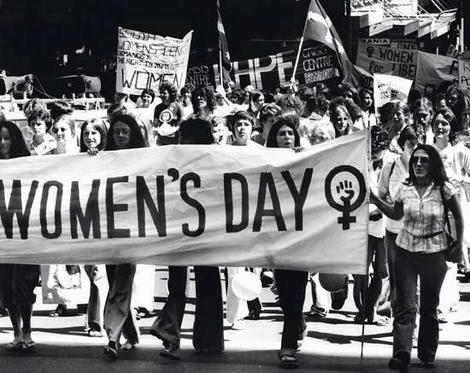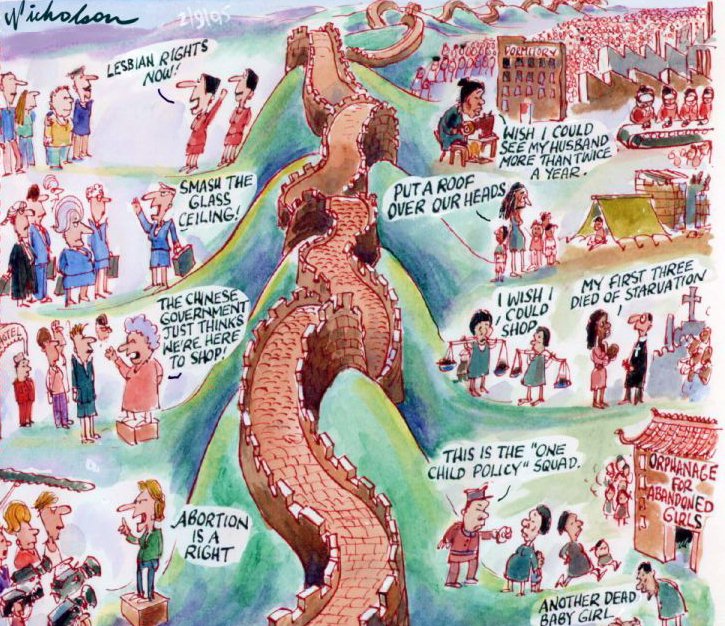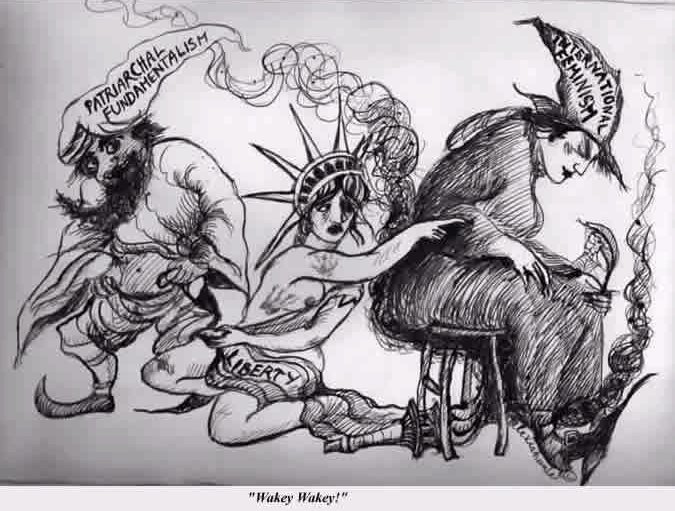 |
||||
|
From International to Transnational Organizing A Century's Feminist Journey
By Val Moghadam
INTERNATIONAL FEMINISM—AND feminist internationalism—have existed since at least the early 20th century, but forms of women's organizing and mobilizing have varied over the past 100 years. Since the 1980s, a new transnational feminism—encompassing Third World countries as well as the core countries—has emerged which requires explanation. Here I will discuss why this development occurred when it did, and tie it to changes in the global economy, the decline of the welfare state, and the rise of Islamic fundamentalism, along with the growth of a population of educated and employed women in developing countries. All of this was occurring in the 1970s and 1980s—hence the formation of transnational feminist networks starting in the mid-1980s rather than earlier. In the early 20th century, international feminism was exemplified by the suffrage movement and the socialist women's movement. Key feminist organizations of the period included the International Women's Council, the International Alliance of Women, and the Women's International League for Peace and Freedom. Within the Second International, the women's organizations of France, Germany and Russia mobilized thousands of working-class as well as middle-class women for socialism and women's emancipation (Boxer and Quataert 1978), although they did not succeed in establishing a feminist socialism (Kennedy and Tilly 1987). Demobilization within the revolutionary women's movement occurred following the collapse of the Second International, after women won the right to vote in many countries, and with Stalin's rise in the Soviet Union. International women's groups continued to meet internationally, though these were no longer mass organizations. Professional women's groups engaged with international organizations such as the League of Nations and the International Labour Organization to expand women's political rights and improve women's working conditions (Berkovitch 1999; Rupp 1998; Stienstra 1994). Political and economic developments in subsequent decades—such as the Great Depression, World War II, and the rise of the welfare state—led movements and intellectuals to focus more on the problems of their own societies, economies and states. In the United States, the climate of anti-communism deterred any large-scale radical movement with an internationalist orientation; the trade union movement had been thoroughly tamed; and America was enjoying a period of capitalist growth and prosperity.
When feminist groups met internationally during the early part of the UN's Decade for Women (1975-85), divisions and disagreements precluded any transnational unity. In the same way that nationalist affiliations and preoccupations had undermined the unity of the Second International, international feminism was divided by East-West hostility, the Palestinian question, and differences over what constituted feminist priority issues. Disputes arose at the first two UN conferences on women, which convened in Mexico City in 1975 and Copenhagen in 1980. For liberal feminists from the First World, the key feminist issues were sexual rights, reproductive freedom, and equality before the law. For many feminists from the Third World, as well as for socialist feminists, priorities were socio-economic and political: the end of hunger, poverty, neocolonialist domination and war—all of which had adverse affects on women's rights and well-being. At the same time, capitalism was undergoing a global restructuring, and soon the world's women were faced with new economic, political and ideological challenges. In response to these challenges, the international women's movement took on a transnational character, and feminist solidarity across borders became a key feature of the networks that formed. A shift in the nature and orientation of international feminism occurred in the mid-1980s, during preparations for the third UN world conference on women, which was held in Nairobi, Kenya in 1985. It was at this time that bridge-building and consensus-making across regional and ideological divides began to take place, and a women's organization of a new type—the transnational feminist network—emerged. Three world-systemic developments triggered this change in the women's movement: (a) the transition from Keynesian to neoliberal economics, along with a new international division of labor that relied heavily on (cheap) female labor; (b) the decline of the welfarist and developmentalist state; and (c) the rise and spread of religious fundamentalist movements. These developments led to new thinking and new forms of organizing on the part of activist women in developing and developed countries—such as the Latin American encuentros, or feminist gatherings—and the emergence of transnational feminist networks devoted to women's economic well-being and their human rights.
Neoliberal Capitalism, the State, and the Rise of FundamentalismIn the 1980s, global restructuring took the form of Reaganism in the United States, Thatcherism in the United Kingdom, and structural adjustment policies and austerity measures in developing countries. It continued in the 1990s in the form of the transition from communism to capitalism in the former Soviet Union and Eastern Europe. One consequence of the post-Keynesian and post-communist transition to neoliberal capitalism was the feminization of poverty. Meanwhile, cross-national research, including studies by those working in the field of women-in-development or women-and-development (WID/WAD), showed that an ever-growing proportion of the world's women were being incorporated as cheap labor into what was variously called the capitalist world-economy, the new international division of labor, or the global assembly line (e.g. Elson and Pearson 1981). Statistical documentation came in the form of UN studies. Research showed that in the 1970s, women began to gain an increasing share of many kinds of jobs, but the post-Keynesian shift was also characterized by growing unemployment, a decline in the social power of labor, an increase in temporary, part-time, casual and home-based work, and cutbacks in social services and subsidies. In the 1980s, women began to be disproportionately involved in irregular forms of employment increasingly used to maximize profits; at the same time, they remained responsible for reproductive work. Female labor incorporation did not entail a redistribution of domestic, household and childcare responsibilities, partly because the welfare services of the state were being cut back. In addition, women remained disadvantaged in wages, training and occupational segregation in the new labor markets. ILO economist Guy Standing (1989) termed this phenomenon the "feminization of labor." He argued that the increasing globalization of production and the pursuit of flexible forms of labor to retain or increase competitiveness, as well as changing job structures in industrial enterprises, favored the feminization of employment in the dual sense of an increase in the numbers of women in the labor force and a deterioration of work conditions, labor standards, income and employment status. As the function of the state shifted from managing social and economic development to providing a conducive environment for businesses and foreign investors in what was soon to be called the era of globalization, the economic well-being of women in developing countries became ever more precarious. In response, a number of transnational feminist networks arose that criticized the new global economic policy environment, including Development Alternatives with Women for a New Era (DAWN), Women in Development Europe (WIDE), the Women's Environment and Development Organization (WEDO). The 1980s also saw the rise of Islamic fundamentalism in Muslim countries and Hindu communalism in India, which compromised women's legal status and human rights. These movements sought to recuperate traditional norms and codes, including patriarchal laws and family roles for women; they put pressure on states to enforce public morality, increase religious observance, and tighten controls over women—ostensibly to protect the nation or culture from alien influences and conspiracies (Moghadam 1994). In some ways they were responses to the creeping homogenization of economic policies, political practices, cultural symbols, and ideology that are now associated with globalization. But they were far from progressive responses. Benjamin Barber has introduced the term jihad as shorthand for religious fundamentalism, disintegrative tribalism, ethnic nationalisms, and similar kinds of identity politics carried out by local peoples "to sustain solidarity and tradition against the nation-state's legalistic and pluralistic abstractions as well as against the new commercial imperialism of McWorld." (Barber 2001: 232) Jihad is in struggle against modernity and cultural imperialism alike, and "answers the complaints of those mired in poverty and despair as a result of unregulated global markets and of capitalism uprooted from the humanizing constraints of the democratic nation-state." (Barber 2001: i) This is an apt way of contextualizing Islamic fundamentalism. In the Middle East and North Africa, Islamic fundamentalist movements emerged in the 1970s, expanded during the 1980s, and peaked in the early 1990s. They reflected the contradictions of modernization, the difficult transition to modernity underway in the region, and the conflict between traditional and modern norms, relations and institutions. Islamic fundamentalist movements emerged as the global economic policy environment shifted from Keynesian to neoliberal, as talks on a new international economic order collapsed, and as world communism went into decline. Islamist movements also emerged as important cultural changes were taking place globally and within countries, including the internationalization of Western popular culture and changes in gender relations, the structure of the family, and the position of women. The Iranian Revolution of 1978-79, which produced the Islamic Republic of Iran, had a demonstration effect throughout the Muslim world. It appeared to many dissidents that a project for the Islamization of state and society could prevail, and that this would be the solution to economic, political, and cultural crises. It is a mistake, however, to view Islamist movements as pristine and spontaneous social movements. During the 1970s and 1980s, many were encouraged and financed by external forces—such as the governments of Saudi Arabia, Egypt, Israel and the United States—in order to undermine left-wing or communist movements. (Hlie-Lucas 1994; Cooley 1999; Moghadam 2003, ch. 5) The emergence of fundamentalist movements in the 1980s alarmed feminists in the developing countries where the movements originated, and they developed innovative strategies to address the problem. One important strategy was to form a transnational solidarity network of anti-fundamentalist feminists, called Women Living Under Muslim Laws (WLUML), in 1984.
|
|
|||
|
|
||||
|
Similarly, Iranian women living in exile in Europe and the United States established feminist groups opposed to the Islamization project in Iran and elsewhere, and networked with WLUML. In Britain, Women Against Fundamentalism and Southall Black Sisters took public positions against growing fundamentalism within the immigrant communities and what they saw as misguided multicultural policies that conceded too much to (often patriarchal) male leaders of immigrant communities.
In Algeria, new feminist organizations formed in the late 1980s in response to the growing power of the Islamist movement. In the refugee camps of Pakistan in the 1990s, the Revolutionary Association of Women of Afghanistan (RAWA) railed against the Taliban and the jehadis (their name for the former U.S.-backed Mujahideen, now called the Northern Alliance). The Sisterhood is Global Institute (SIGI), under the direction of an expatriate Iranian feminist, advanced the cause of Muslim women's human rights, and helped to establish a regional branch in Amman, Jordan. All these groups used the new computer technologies, as well as opportunities afforded by the UN's international conferences of the 1990s, to share information, exchange ideas, extend solidarity, and expand their organizations. Neoliberal capitalism and religious fundamentalism remain the key threats to women's autonomy, equality, and empowerment, and transnational feminists have linked both to violence against women. The Gloria Declaration—issued by the 8th International Women and Health Meeting in Rio de Janeiro in March 1997—identified globalization of the market economy and religious fundamentalism as the two major systemic obstacles to achieving women's health, security and rights. The Gloria Declaration stressed the culpability of Christian and especially Catholic restrictions on women's sexual autonomy, as well as Islamic fundamentalism, and criticized the role of the Vatican at venues such as the 1994 ICPD in Cairo and the 1995 Beijing Conference. And the World March of Women 2000, a two-year initiative of feminists in Quebec that culminated in worldwide protests in October 2000, declared itself to be against neoliberal capitalism and violations of women's human rights, and offered proposals for the restructuring of economic and political institutions and norms of global governance. TFN (Transnational Feminist Networks) activities as well as partnerships with other transnational advocacy networks resulted in some significant achievements in the 1990s. When the Taliban came to power in Afghanistan in September 1996, many governments were close to recognizing the new regime. But in response to pleas from Afghan feminists in Pakistan and elsewhere, feminists mobilized across the globe and lobbied their governments to diplomatically isolate the Taliban. As a result, the Taliban regime was recognized by only three governments—those of Pakistan, Saudi Arabia and the United Arab Emirates. TFN successes at the UN conferences of the 1990s should also be mentioned. TFN lobbying led to the insertion of important items in the final Vienna Declaration of the 1993 Conference on Human Rights, such as the assertion that violence against women was an abuse of human rights, and attention to the harmful effects of certain traditional or customary practices, cultural prejudice and religious extremisms. The Declaration also stated that human rights abuses of women in situations of armed conflict—including systematic rape, sexual slavery, and forced pregnancy—were violations of the fundamental principles of international human rights and humanitarian law. This culminated in passage of an international law in 1998 that designated rape a war crime when carried out during civil conflict or war. TFNs were also influential at the 1994 ICPD and the 1995 Beijing Conference, where they lobbied to prevent the coalition of conservative Muslim, Catholic and Protestant delegations from blocking agreement on reproductive rights. At the 1995 Beijing conference, TFNs succeeded in extracting promises from the World Bank's new director, James Wolfensohn, for institutional changes that would ensure the integration of gender issues in World Bank policies, projects, and lending practices. In the new milennium, the global feminist agenda includes the insistence that women's human rights and the social rights of working women be integrated into state policies, trade agreements, and the programs and policies of international organizations. Transnational feminist networks such as DAWN, WIDE, WEDO, and the Women's International Coalition for Economic Justice (WICEJ) issue critiques of multinational corporations, the World Bank, IMF, WTO and the policy stances of the United States government. Women's groups have joined broad coalitions (e.g. the anti-MAI campaign and Jubilee 2000 for Third World debt cancellation) involving labor, religious, environmental and human rights groups to challenge corporate capitalism and global inequalities. Like other groups within the global justice movement, TFNs have argued that the new rules of global free trade undermine existing national laws that protect workers, the environment, and animals; and that WTO intellectual property provisions have allowed large corporations to appropriate (through patents) the knowledge and products of Third World countries and their local communities. Additionally, transnational feminists argue that the employment losses and dislocations brought about by the new international trade agreements have been disproportionately borne by women, that trade liberalization often put women entrepreneurs and small business owners at a disadvantage, and that neoliberal policies and the neoclassical economic theories that inform them are biased against women and labor (see e.g., WIDE 1998, 2002). TFNs, therefore, have contributed the idea that gender justice is inseparable from economic justice, and that women's human rights—including their rights to equality within the family—must be considered part of the broad human rights agenda.
A Transnational Feminist Socialism?A century ago, middle-class and working-class women mobilized for suffrage and socialism. Capitalism spread and took on militaristic forms, but it also incorporated some feminist and democratic demands. The socialist movement left a brilliant legacy—including International Women's Day—but the international women's movement did not experience significant mobilizing again until the end of the century. The new economic and political realities of late capitalism led to new forms of organizing and a convergence of feminist perspectives across the globe. For many First World feminists, economic issues and development policy became increasingly important; for many Third World feminists, increased attention was now directed to women's legal status, autonomy and human rights. Since then, transnational feminist networks have proliferated and although each tends to have a specific focus, they all have adopted the broad global feminist agenda that is critical of neoliberal capitalism and religious fundamentalism and calls for expanded civil, political and socio-economic rights for women. These demands are compatible with other demands within the global justice movement for a kind of global Keynesianism in which decent work, labor rights and democratic governance underpin economic development and growth strategies (Kohler 1999). History may or may not repeat itself, but it is interesting to note that the early 20th century call for social democracy seems to be resounding in the early 21st century. This time, however, feminism is far more influential—and transnational—than before, with a greater likelihood that any new wave of socialist democracy will be feminist too. References Cited
|
||||
 |
|
 |
||



